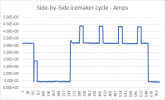mapguy525
Solar Enthusiast
Do you have a residential 120v fridge? Sounds like your running fridge via the inverter while driving down the road. Is that the situation?
I agree. Not getting enough charge out of available sources for the battery load during driving. This deficit has lead to the 6v batteries being overdrawn repeatedly without full charge.I still feel the system is a bit under spec'ed. 450ah is 225ah in reality. Those batteries will need a fairly decent current for bulk charge and a long absorbtion time. If the load is operating while this is happening, the sun hours might have difficulty keeping up. This gets worse in sub optimal conditions. I used lead acid for 7 years, a usable 300ah and it amazed (and disappointed) me the reality of how much energy I needed to harvest simply to keep the batteries healthy. I couldn't keep up in winter.
Totally agree - need to pinpoint the fault if present and resolve. Analysis of actual battery load vs. capacity is need here, too. This is a common situation with OEM installed Residential fridges using inverters doing power pole to power pole travel.ALL the above are excellent solutions BUT first lets find the problem ... is it power/amps coming in .. is it the batteries ...or is there a vampire drain ... all of these are relatively easy to find -- and once the issue is found THEN we can focus in on how to fix .. I don't want to over load him with fixing things or swapping out things that right now may NOT be the issue -- good ideas but not the issue ... hopefully he lets us know soon how tings are progressing ....
Was 27 and it has gone up to 33.00 ... still WELL worth every cent considering what it can do .. I carry this thing with me instead of a $600 fluke ...
I finally realized that lower end fridges often have energy saver mode. That actually cut down the energy use by a lot! (Especially the high peak heater function. )


850-1100 is what I see for the defrost sometimes- that instantaneous draw is rough on small inverter gens.With Icemaker off, the side-by-side fridge was drawing 3.0A, 360W. The defrost cycle was close to 5.0A, 600W. The graph looks like I captured one startup surge of 8.0A, 960W but probably instantaneous surge was much higher.
Here's a short set of data with Icemaker running:
View attachment 15285
With Icemaker, on cycle lasts longer and is about 3.2A. The repeated heating of ice cube tray is slightly under 4.5A
I took this data in April with mild weather, house at comfortable temperatures.


